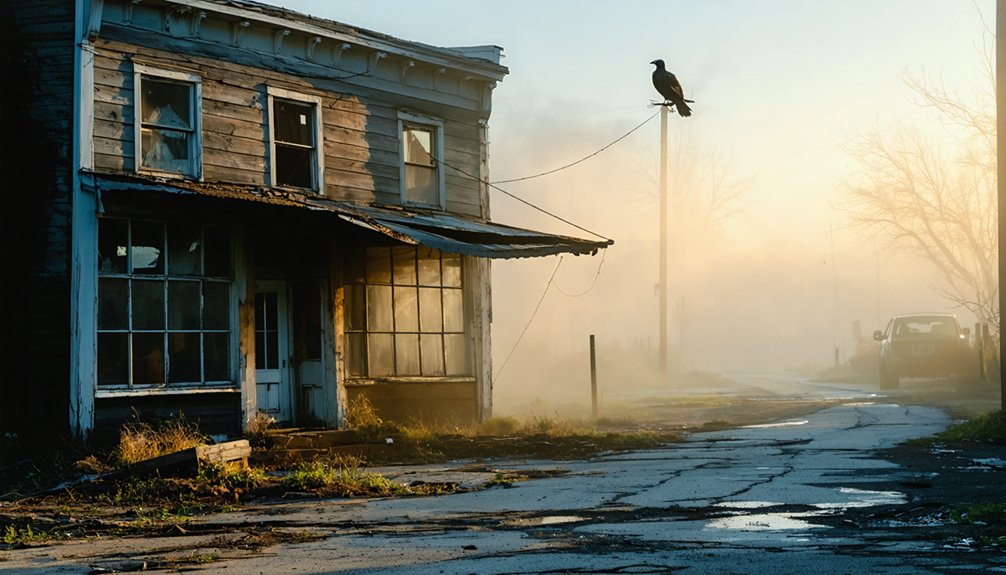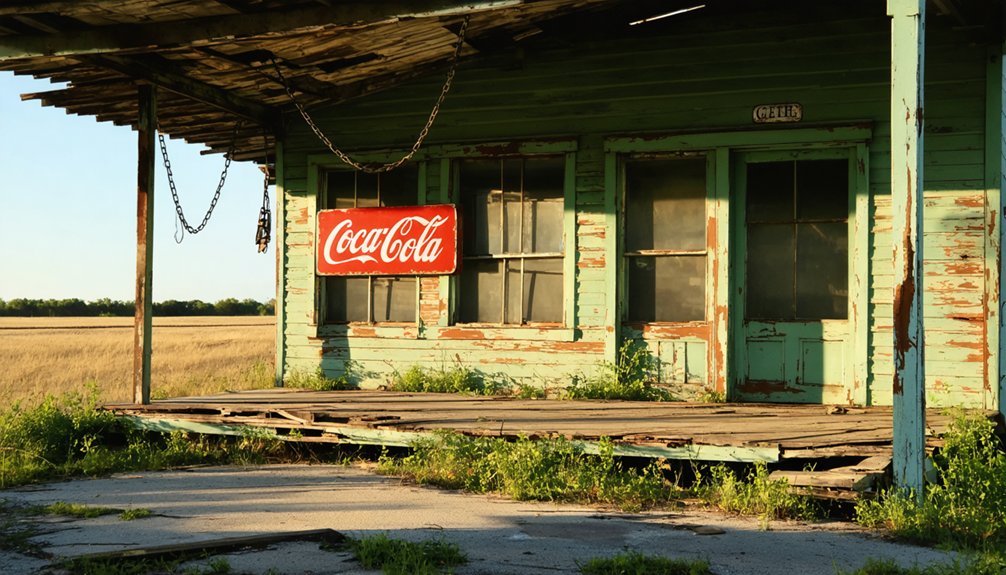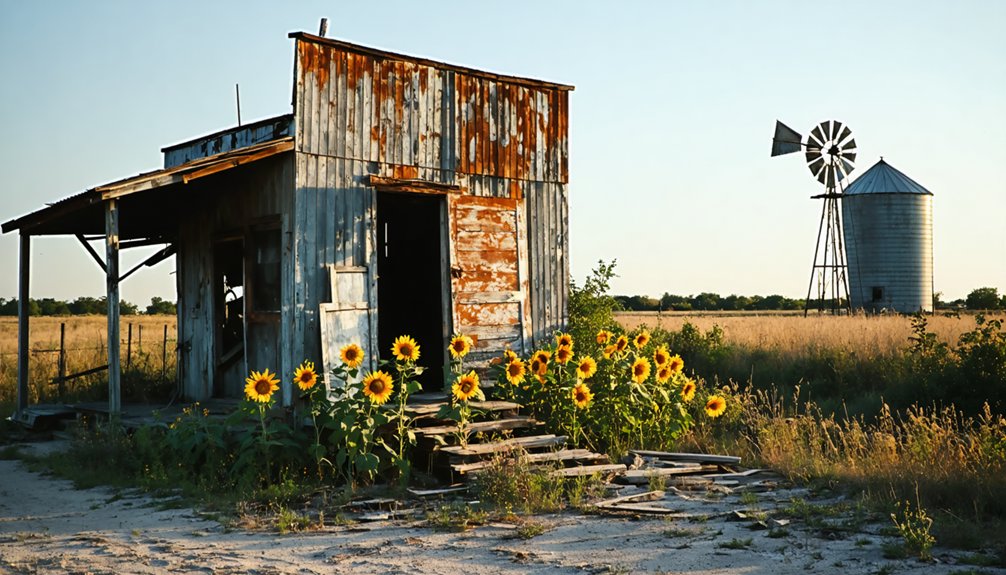You’ll find Zuehl, Texas nestled along Cibolo Creek in Guadalupe County, where German immigrant Carl Christian Zuehl established this settlement in 1846. The town once thrived with a general store, post office, and the historic Clemens School serving as community anchors. While most structures have vanished, you can still visit the transformed Zuehl Saloon (formerly the general store) and explore local cemeteries. The area’s rich history includes haunting tales and mysterious sightings that add to its ghostly allure.
Key Takeaways
- Zuehl was founded by German immigrants in the 1840s, with Carl Christian Zuehl establishing a legacy in Guadalupe County, Texas.
- The community thrived around Zuehl’s General Store, established in 1872, which later became Zuehl Saloon in 2016.
- The town’s decline began when new highway systems bypassed the area, leading to decreased commerce and population.
- Today, Zuehl exists as a ghost town with minimal physical remnants, most of which are on private property.
- The abandoned structures, including the general store, are reportedly haunted with paranormal activity and ghostly sightings.
A Pioneer’s Vision: The Founding of Zuehl
When Carl Christian Zuehl immigrated from Prussia to Texas in 1846, he laid the foundation for what would become a remarkable German-Texan legacy in Guadalupe County. Born in 1797 near Greifswald in Pommern, this pioneering patriarch brought his cultural roots from Tribsees, Stralsund, planting them firmly in Texas soil.
His pioneer dreams took physical form when his son Ferdinand purchased property in the early 1870s and established Zuehl’s store in 1872. This commercial venture became the heart of the growing settlement. The building, which started as a meat market, served multiple purposes over the decades.
Wilhelm Zuehl further cemented the family’s commitment by establishing the Zuehl Family Cemetery and organizing community workdays. The cemetery was enclosed by a distinctive wrought iron fence acquired from the Seguin Courthouse. Through eight generations, the Zuehl family’s vision shaped this German-Texan community, developing it from a simple creek crossing into a thriving rural settlement.
Early Settlement and Community Growth
The broader wave of German immigration to Texas in the 1840s set the stage for Zuehl’s development as a vibrant agricultural community.
Led by Carl Christian Zuehl, who emigrated from Pommern, Prussia, the settlement took root in the fertile lands of Guadalupe County during the 1860s. You’ll find that the town’s agricultural practices centered on cotton farming, which became the economic backbone of the community.
The Zuehl family’s influence extended beyond farming, as they helped establish lasting cultural traditions that defined the area’s identity. The Historical Preservation Committee continues documenting the area’s rich heritage today. Like their fellow German settlers in Blumberg Cemetery, established in 1845, the Zuehl community maintained strong ties to their cultural heritage.
The Germania Bowling Club emerged as a demonstration of the community’s social cohesion, while surviving original family homes and landmarks like Zuehl Road continue to connect modern visitors to the pioneering spirit of these early German settlers.
The Heart of Town: Zuehl’s General Store
Standing as a tribute to Zuehl’s pioneering spirit, the community’s general store originated around 1872 when Ferdinand (or Wilhelm) Zuehl established it shortly after purchasing local land.
Beyond serving as a retail hub, the store became the beating heart of local life, hosting community gatherings and fostering crucial connections among settlers. Like many general stores of its era, it served as a third space where locals could socialize while conducting their daily business.
Located in western Guadalupe County, the historic building sits along Cibolo Creek, offering a glimpse into the area’s rich past.
You’ll find this historic landmark has worn many hats through the years, transforming from a meat market to a general store, and now serving as the Zuehl Saloon after careful renovation in 2016.
The building’s historical significance lives on through its current role as an event venue.
- Experience the legacy of rural Texas freedom at a site where pioneers once traded goods and stories
- Connect with authentic German heritage preserved in every weathered board
- Become part of a continuing story where community bonds remain strong
Education and Social Life: Clemens School
Built in the early 1880s, Clemens School emerged as an essential educational cornerstone in Zuehl’s development, serving generations of local children while anchoring community life in Guadalupe County.
You’ll find this one-room schoolhouse still standing today alongside the historic saloon, one of the few original structures remaining in town.
Beyond its educational role, the school’s historical significance stems from its position as a hub for community gatherings, local meetings, and social functions. Two churches operated in the area during the 1960s, further enriching the community’s social fabric.
The building’s preserved architecture reflects typical rural Texas school construction of the late 19th century, with modest but functional facilities that accommodated multiple grades under a single teacher. The school would later influence naming traditions in the region, as seen when Samuel Clemens High School was established through a community naming contest in nearby Schertz.
Simple yet purposeful, these one-room schoolhouses embodied rural Texas education, housing many grades and one teacher under a single roof.
While a separate school existed for Black children in the nearby Clemons community during the 1930s, Clemens School helped shape Zuehl’s identity through several generations.
Postal Service and Communication Hub
As you explore Zuehl’s early communication systems, you’ll discover that its postal operations aligned with Texas’s broader development of mail routes following the Republic’s 1835 establishment of postal services.
The establishment of postal roads connected Zuehl to neighboring towns and facilitated regular mail transport throughout the region.
Like other communities of the era, Zuehl’s mail delivery relied heavily on slow wagon trains for transportation.
You’ll find that Zuehl’s post office, like many rural Texas communities, served as an essential hub where residents gathered to collect mail and exchange news.
The introduction of Rural Free Delivery around 1900 transformed Zuehl’s postal services, enabling direct mail delivery to the area’s scattered farmhouses and homesteads.
Mail Routes Established
Three major mail routes converged near Zuehl during its early development as Perryman’s Crossing, with the Wood Road serving as the primary transportation corridor between Gonzales and San Antonio before 1830.
The mail route evolution transformed Zuehl into an essential link within Texas’s growing communication network, connecting it to larger stations along the San Antonio-El Paso Road. These communication corridors adapted to meet settlers’ needs, prioritizing water access and security.
- You’ll find traces of the original Wood Road, where countless letters and crucial messages once traveled between isolated frontier communities.
- The routes tell stories of determination, connecting families and fostering commerce across the untamed Texas landscape.
- These historic pathways represent the spirit of independence, as settlers established their own connections in the wilderness.
Post Office Operations
The late 19th century brought significant change to Zuehl when its post office opened, building upon the town’s established mail route network.
You’d find the postal facility operating from local postmasters’ homes or adjoining stores, serving as both a mail processing center and community gathering spot.
This essential hub of Zuehl’s postal history connected you to the wider world through horseback and stagecoach deliveries. You could send personal letters, handle business transactions, and receive important government notices.
The post office strengthened community connections by enabling local merchants to place orders, ranchers to conduct business, and families to maintain contact with distant relatives.
The facility’s significance extended beyond mere mail handling – it represented Zuehl’s viability and helped attract settlers seeking reliable communication infrastructure in rural Texas.
Transportation Routes and Economic Impact
Zuehl’s initial growth centered on its strategic position as a railroad stop, where the tracks served as a crucial lifeline for agricultural shipping and passenger transport.
You’ll find evidence of earlier stage coach routes that once connected the settlement to regional trade networks, though these were eventually superseded by rail transportation.
The town’s ultimate decline began when new highway systems, particularly Highway 87, bypassed Zuehl entirely, redirecting commerce and travelers to better-connected communities.
Railroad Access Points
Railroad access played a pivotal role in shaping Zuehl’s development and eventual decline, with key rail corridors connecting this small Texas settlement to regional markets throughout South Texas.
The San Antonio and Aransas Pass Railway (SA&AP) provided essential freight transportation services, while the Galveston, Harrisburg and San Antonio Railway enhanced regional connectivity.
You’ll find that Zuehl’s railroad significance stemmed from its strategic location near these crucial rail networks, which served as lifelines for local commerce and trade.
- You can still spot remnants of old rail spurs that once bustled with cattle cars and cotton shipments.
- The abandoned rail points stand as silent witnesses to Zuehl’s former prosperity.
- These historic routes remind us of the freedom of movement and opportunity the railroad once promised.
The gradual shift to highways and reduced rail service ultimately contributed to Zuehl’s transformation into a ghost town.
Stage Coach Travel Routes
Before the railroads revolutionized transportation in Texas, stagecoach routes formed an important network connecting Zuehl to major regional hubs like San Antonio, Austin, and Houston during the 1870s.
You’d find stagecoaches departing daily on fixed schedules, following paths that traced natural ridgelines and creek fords to guarantee reliable passage even in challenging weather.
If you’d traveled these routes, you’d have experienced the typical discomforts of stage travel – cramped quarters with up to fourteen other passengers, jarring rides, and occasional delays due to muddy conditions.
The routes weren’t just for passengers; they served as crucial mail corridors under government contracts, keeping Zuehl connected to larger markets and news sources.
This reliable transportation network helped foster economic growth in the region before railroad development.
Town Bypasses Impact Growth
While stagecoach routes and railroads once brought prosperity to Zuehl, the construction of bypass roads in the mid-20th century proved devastating for the town’s economic significance.
You’ll find that modern bypass effects rippled through the community as new highways diverted traffic away from the original settlement. When TxDOT prioritized regional traffic flow over local access, Zuehl experienced dramatic economic shifts that transformed it into a ghost town.
- Your business opportunities vanished as customer traffic dwindled, leading to closed storefronts and abandoned buildings.
- Your property values plummeted when commercial activity migrated to new developments along bypass corridors.
- Your town’s tax base eroded, making it harder to maintain essential services and infrastructure.
The lack of direct highway access continues to isolate Zuehl from modern transportation networks, perpetuating its decline.
The Gradual Decline of a Texas Settlement
As economic shifts transformed rural Texas throughout the 20th century, Zuehl experienced a gradual decline that mirrored many small settlements across the state.
Despite efforts at economic adaptations, the town couldn’t maintain its liveliness as younger residents moved away in search of better opportunities. You’ll find that this pattern of decline intensified when transportation routes changed, bypassing the once-bustling community.
The town’s community resilience was tested as essential services began to disappear. Schools that once buzzed with activity closed their doors, while local businesses struggled to stay afloat.
The aging population found themselves increasingly isolated as services dwindled. What you’re seeing in Zuehl today reflects the broader rural-to-urban migration that reshaped Texas, leaving behind quiet streets where spirited community life once thrived.
Haunting Tales and Local Legends

You’ll encounter the most striking paranormal activity at the abandoned general store, where witnesses report seeing a veiled woman in black walking through walls and hearing phantom conversations from long-ago customers.
The town’s cemetery intensifies its otherworldly reputation after sunset, with visitors documenting orbs, unexplained cold spots, and the ghostly figure of an elderly woman in white who appears between the weathered headstones.
Along the old railroad tracks at midnight, you can sometimes hear the distant whistle of trains that no longer run, accompanied by the sounds of phantom footsteps and children’s laughter echoing through the empty station grounds.
Ghostly Store Encounters
Though many ghost towns harbor tales of supernatural occurrences, Zuehl’s Adobe Verde restaurant stands out for its well-documented paranormal activity.
In this former 1920s electric cotton gin, you’ll encounter ghostly phenomena linked to a mischievous spirit named Frank, who’s known for his playful pranks and unexplained disturbances.
The spectral narratives include mysterious object movements, flickering lights, and distinct cold spots throughout the building.
- Experience sudden, inexplicable noises when you’re alone in the store area
- Feel the hair on your neck rise as unseen presences brush past you
- Watch in amazement as items mysteriously relocate themselves
These encounters have transformed Adobe Verde from a simple Tex-Mex restaurant into a powerful symbol of Zuehl’s haunted heritage, drawing curious visitors seeking connections to the supernatural domain.
Cemetery After Dark
Deep within Zuehl’s abandoned landscape, the historic cemetery stands as a haunting memorial to the town’s storied past, where weathered tombstones from the late 19th and early 20th centuries tell silent tales of Civil War veterans and pioneer families.
You’ll encounter more than just history here after sunset. Visitors report unexplained cold spots and shadowy figures during their cemetery rituals, particularly near the grave of Confederate veteran Hyram Barry Rogers.
Ghost sightings include the mysterious “silent mourner” who appears on moonlit nights, and a phantom caretaker who seemingly watches over the grounds. The dense brush and aging trees cast eerie shadows across intricate headstones and wrought iron fences, while unexplained orbs appear in photographs.
Some even witness fresh flowers mysteriously appearing on untended graves, despite no known visitors.
Midnight Railroad Whispers
Three haunting tales echo through Zuehl’s abandoned railroad corridor, where phantom whistles pierce the midnight air and ghostly figures patrol the deteriorating tracks.
As you walk along the former Texas Midland route, you’ll discover a rich tapestry of railroad lore that’s deeply woven into local history.
Like Ghost Hill between Palmer and Ferris, Zuehl’s spectral trains remind us of the area’s bustling railway past.
- Midnight sightings of Otto William Zuehl’s spirit, still performing his duties as railroad agent along the shadowy platforms
- Phantom whistles and unexplained bell ringings that harken back to the days of all-steel boxcars rumbling through the prairie
- Italian railroad workers’ apparitions, their ghostly forms maintaining eternal watch over the tracks they once built
Preserving Zuehl’s Historical Legacy

As ghost towns across Texas fade into obscurity, preserving Zuehl’s historical legacy has become increasingly crucial for maintaining the region’s cultural heritage.
You’ll find that community preservation efforts, led by local historical societies and volunteers, play an important role in safeguarding the town’s remaining structures and artifacts. Through historical documentation initiatives, including photography, oral histories, and archaeological surveys, you’re able to piece together Zuehl’s significant contributions to Texas’s westward expansion.
You can participate in various preservation activities, from joining guided tours to supporting local fundraising events. By working with the Karnes County Historical Society Museum and engaging in digitization projects, you’re ensuring that Zuehl’s story lives on for future generations.
These combined efforts help protect not just the physical remnants, but the rich cultural narrative that makes Zuehl unique.
Modern Day Remnants and Site Access
While exploring Zuehl’s current landscape, you’ll find minimal physical remnants of the once-thriving community. The site’s modern access is primarily restricted by private land ownership, requiring you to obtain permission before visiting.
What remains today has largely reverted to agricultural land, with deteriorating foundations and scattered ruins telling the story of its past.
- Stand before weathered building remains that whisper tales of frontier determination
- Walk the grounds where pioneering families once built their dreams
- Experience the profound silence of a community reclaimed by nature
Without formal site preservation efforts, Zuehl’s physical traces continue to fade.
You’ll need to navigate rural roads and possibly utilize off-road vehicles to reach accessible areas. Remember, there aren’t any visitor amenities, so come prepared for a self-guided exploration of this forgotten piece of Texas history.
Frequently Asked Questions
What Is the Current Population of Zuehl?
You’ll find the current demographics show about 299 residents in 2025, with population trends indicating a slight decline from 301 in 2023 and a notable drop from 399 in 2020.
Were There Any Notable Crimes or Tragedies in Zuehl’s History?
Like a smartphone in 1890, recorded crime was non-existent in Zuehl’s history. You won’t find documented criminal incidents or major tragedies – it’s one of Texas’s ghost towns with a peaceful past.
What Native American Tribes Originally Inhabited the Zuehl Area?
You’ll find the Coahuiltecan peoples, particularly the Payaya band, were the original Native tribes in your area, though Comanches and Apaches later extended their historical influence into the region.
Did Any Famous People Ever Live in or Visit Zuehl?
You won’t find records of any famous visitors or nationally recognized figures in this community. The area’s historical figures were primarily local pioneers from the Zuehl family and German settlers.
What Was the Highest Recorded Population of Zuehl During Its Peak?
You’ll find the peak population reached 399 residents in 2020, marking its historical significance as the highest recorded count before declining to an estimated 319 by 2025.
References
- https://www.county.org/county-magazine-articles/summer-2025/ghost-towns
- https://www.hauntedplaces.org/zuehl-tx/
- https://mix941kmxj.com/the-strange-sad-story-of-a-texas-ghost-town-youll-never-visit/
- https://www.ghosttowns.com/states/tx/zuehl.html
- https://texashighways.com/travel-news/four-texas-ghost-towns/
- https://www.youtube.com/watch?v=phjUE19A8HM
- https://en.wikipedia.org/wiki/List_of_ghost_towns_in_Texas
- https://www.texasescapes.com/CentralTexasTownsSouth/Zuehl-Texas.htm
- https://www.tshaonline.org/handbook/entries/zuehl-tx
- https://shalemag.com/the-zuehl-saloon/



